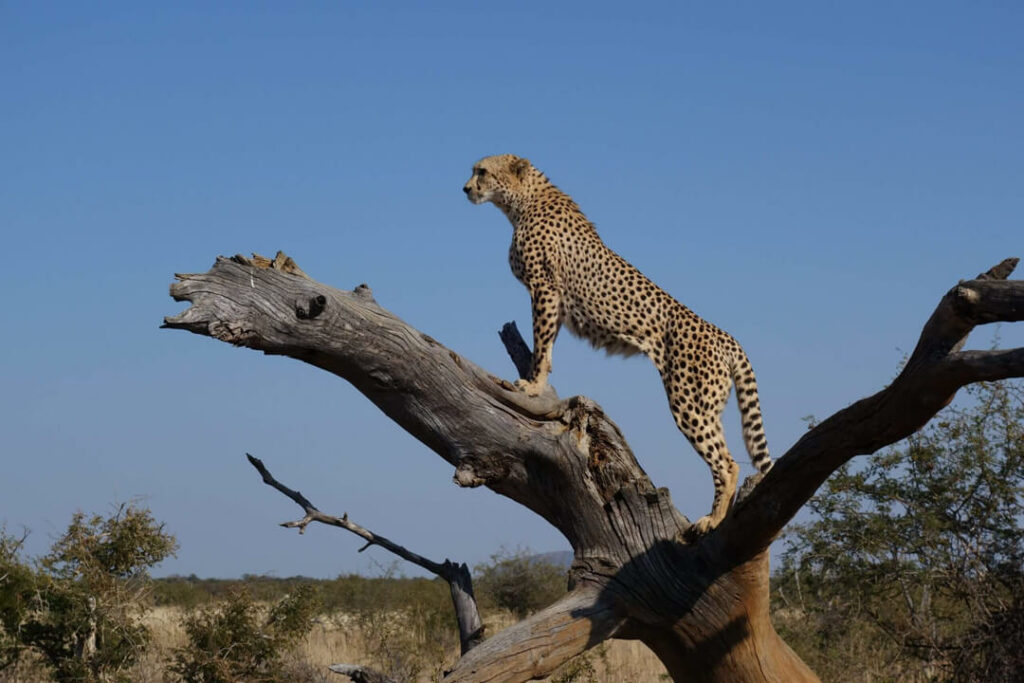Let’s be honest: Nothing is more exciting than spending a month preparing for your choice of an African big game hunt! With the remarkable variety of species in Namibia, it is an extraordinary game hunting destination. Excitement and nervousness before the hunt, and counting down the days until D-Day, keep you going! The overall trip isn’t just about the trophy hunting in Africa that gets done, but also about the beautiful bush views and the memories created while relaxing around a bushveld fire with your friends and family around. Any type of game hunting in Namibia will be unforgettable, let alone a big game animal when your adrenaline is pumping, and your nerves are through the roof!
[DYNAMIC-BLOGTABLEOFCONTENT]
What Species Can I Hunt in Namibia?
Classification of big game hunting falls into three main categories:
- Dangerous Seven
- Larger antelope
- Animals are often hunted on a big game safari.
The Dangerous Seven includes the African elephant, buffalo, lion, leopard, rhino, hippo, and Nile crocodile. Larger game, such as greater kudu and Cape eland, are also considered big game. Cheetahs and hyenas are often hunted on big game hunting safaris, even though they are not the largest creatures. While the rhino is a part of the Dangerous Seven, it is usually referring to the black rhino (hook-lipped rhino) as they are tougher to hunt, especially on foot, due to their aggression when compared to the white rhino (square-lipped rhino). Cheetah hunts take place in Namibia and Zimbabwe, but cheetah hunting in Namibia is renowned as the best in Africa!
With a surface area of 318,261 square miles, Namibia ranks as the 34th largest country worldwide. Its wide open plains, grasslands, savannas, and deserts make it one of the world’s most sought-after hunting destinations for a range of wildlife.
Where are Namibia’s Best Game Hunting Destinations?
- Hunting can be done throughout Namibia, with some areas being more popular than others, depending on your chosen species.
- Namibia’s Caprivi Strip is among the best African game hunting destinations, especially for the Dangerous 7.
- The Caprivi Strip is on the Eastern tip of Namibia in a small town called Katima Mulilo.
- Namibia, Angola, Zambia, and Botswana border the Caprivi Strip.
- Monster Cape eland hunts take place in central Namibia.
- The greater kudu is found in central and northern Namibia, tending to stick to the grasslands and rocky terrain.
- Cheetahs are found in part of Namibia and love to spend their time on cattle farmlands and more open areas.
- Due to their immense speed and chosen locations, cheetah safaris are an excellent option for big game hunting in Namibia.
- Hyena are found throughout Namibia, except the north-eastern and south-eastern parts of the country.
- Rhinos are found in the northern parts of the country and prefer habitats of open savannas and grassland regions.
Is Namibia a popular game hunting destination?
Namibia is one of the top hunting destinations worldwide and is also the only other country that offers all five species of the Big 5 hunting in Africa to be hunted. The Department of Environmental Affairs (DEA) banned leopard hunting in 2016, however, the South African government has said that permits will be made available, but nothing has been forthcoming as yet. Aside from the Big 5, Namibia offers other two members of the Dangerous Seven, the Nile crocodile, and the hippopotamus. Namibia is often referred to as the land of contrasts. From boiling weather in the desert regions to icy winds on the Skeleton coast, with its regions experiencing vast differences in weather, terrain, and topography. However, throughout the country with its contrasts, lie many hunting jewels, just waiting to be discovered.
Nambia at a Glance
- Namibia is very hot and dry with inconsistent and sparse rainfall.
- Namibia can reach temperatures of 86-95°F and even hotter in the desert regions of the country during the summer months.
- In the winter temperatures will drop to 57-60°F and can get much colder during the night reaching close to freezing temperatures, once again, especially in the desert regions.
- The country experiences its dry season from April to October and has its rainfall from November to March.
- At the end of April and beginning of May, the grasses will still be long and thick making hunting Namibia a challenge at times and should be taken into consideration for game hunters wanting to travel over this time.
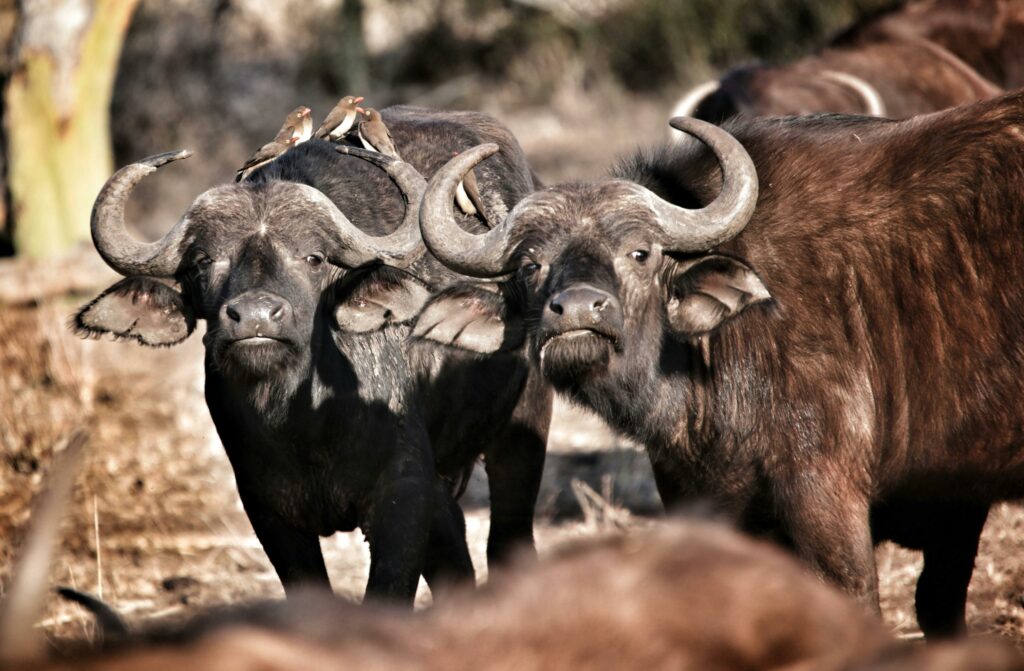
Shot Placement
Shot placement on a Buffalo
- Many of the coutadas offer Cape Buffalo. Marromeu in the north produces some exceptional trophies. I have hunted that area, and the swamp lands and tall cut grass make it exceptionally challenging.
- During the dry season, hunters gain access using 4×4 vehicles. In the wet season a hunter can walk up to 15 miles a day. else in the wet it is walking on average about fifteen miles a day.
- Like with big game fishing, a good tip is to look out for birds circling above the buffalo. The terrain can be so flat and wet that it is almost impossible to identify fresh tracks. This, of course, depends on the season.
- While a nice balanced double works nicely on a buffalo, when it comes to buffalo hunting in Marromeu, I would recommend a .375 or a .458 mounted with a decent scope. The reality is that because the hunter may be shooting a target bull out of a herd, shooting distance may vary from sixty yards to two hundred yards. It is sometimes just impossible to get close.
- Following up on a wounded buffalo in this terrain certainly gets the heart pumping and the adrenaline rushing through your system.
Shot placement on Leopard, Cheetah and Hyena and Lion
These three species should all be shot one-third of the way up near the shoulder. No one wants to be chasing after any one of these predators if they are wounded so good shot placement is critical. If one of these animals is facing you directly then you should aim for the base of the neck and central in the legs giving you a sweet spot in the chest.
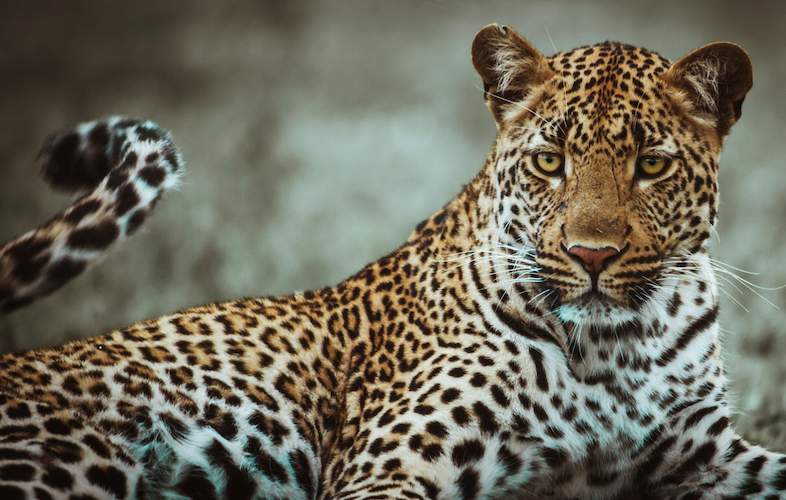
Shot placement on a Hippo
- Hippos are often targeted in the head if they are not on land.
- They spend their time in the water with only their eyes and ears sticking out, making a brain shot necessary.
- If the hippo is in the water and facing the hunter, the shot must be aimed at the small triangular indentation that sits just above the eye-to-eye centreline.
- If the hippo is facing sideways to the hunter, the shot must be aimed just below the ears, sending the bullet into the brain.
- Once the hippo has been shot, it will sink to the bottom of the river or dam due to its mass.
- If the shot is placed properly and fatal, it can take as long as two hours for the decomposition gasses to cause the hippo to rise to the surface and float.
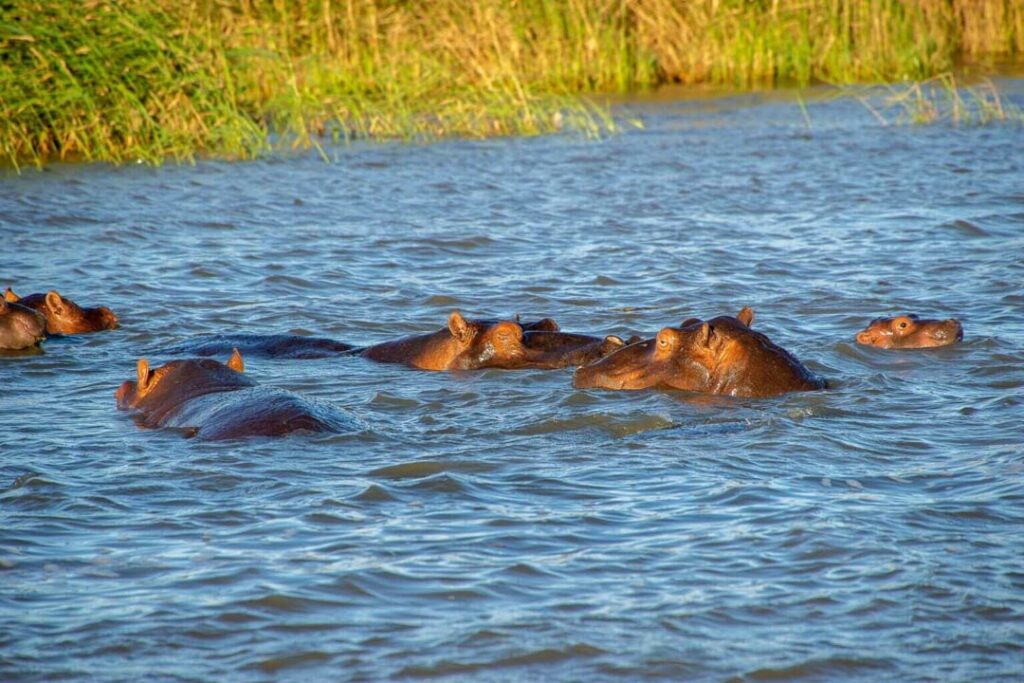
Shot placement on an Elephant
If a broadside shot of an elephant is presented, then the hunter must aim at the spot where the front leg meets the body. This is where the elephant’s heart is located and if the hunter just misses the heart, a double-lung shot will most likely be where the bullet ends up. A neck shot is not always advisable as the neck muscles are extremely tough and thick. A frontal shot on an elephant will only be in the brain, the shot angles and places to aim will change depending on the distance from which you are shooting. A spinal shot may be required if the elephant does not drop, and is running away. This, however, is very unusual. Due to there being so many angles and different shots, it can make elephant hunting in Namibia a difficult task that requires remarkable accuracy.
Shot placement on a Rhino
- On a broadside shot on a rhino one-third of the way up, on the shoulder will put a rhino down.
- If the rhino is broadside, there will be a roll of skin that is formed, the hunter must aim just behind this roll of skin.
- This allows a well-aimed heart shot.
- If the hunter misses the heart, then a lung or double lung shot will still take a rhino down.
Shot placement on a crocodile
- There are different shots a hunter can take on a crocodile and will depend on what the PH thinks is best.
- The first shot is a frontal brain shot; the hunter will aim in between the eyes of the crocodile to slip the bullet into the brain.
- The side brain shot spot is located above the smile of the crocodile and behind the eye.
- The spine shot is also an option which is two or three inches behind the smile and into the neck and will drop a crocodile on the spot.
- There is also the usual heart shot which will take the animal down.
- A headshot of a crocodile is often what some PHs will suggest, however in some places the water depths are very low and a headshot that isn’t perfectly in the brain can cause the crocodile to end up at the bottom of the lake or river, unable to be retrieved.
- For this reason, some PHs might suggest a neck shot first.
Shot placement on Cape Eland and Greater Kudu
The shot placement on an Eland or Kudu is just the standard broadside approach of one-third of the way up the shoulder aiming for a heart or lung shot.
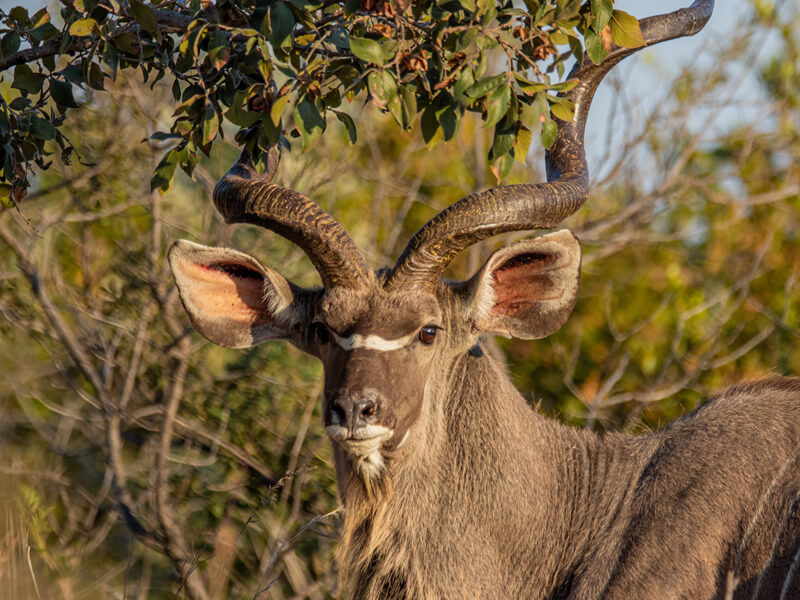
Rifles, Rounds & Bow Hunting
What rifle caliber should I use for big game hunting in Namibia?
The smallest rifle you can legally hunt in Big Five and Dangerous Game is a 375. Even though elephant hunting can be done with a 375, it is typically done with a 458 or anything higher due to the open sights and close-range action. Animals such as cheetahs, brown hyenas, spotted hyenas, Cape elands, and kudus can still all easily be taken down by a 30-caliber rifle. Even if one is using large calibers shot placement is still extremely critical.
Minimum bow specification required in Namibia
The following lists show what bow specs are required and recommended to have the best bow experience hunting in Namibia:
- Medium-sized games such as cheetah, brown hyenas, and spotted hyenas will require a minimum draw weight of 50 pounds and an arrow weighing no less than 400gr.
- Larger animals such as eland, leopard, and kudu will require a minimum draw weight of 60-75 pounds (60 pounds for kudu and 70 pounds for Cape eland) and a minimum arrow weight of 500gr.
- Buffalo requires a minimum draw weight of 80 pounds and an arrow weight of 600gr or higher.
- Rhinos, hippos, and giraffes require a minimum draw weight of 95 pounds and an arrow weight being no less than 800gr.
- Any draw weight higher than 70 pounds is good for crocodiles, but a higher draw weight is recommended. A minimum arrow weight of 695gr is required.
- Elephants require a bow that takes 80 pounds to pull back, but it STRONGLY recommends going to anything over 100 pounds at least. A 700gr arrow is required.
Namibia: Top Game Hunting Destination
Namibia has not received accolades as being a top game hunting destination in vain, it offers hunters a range of game to suit their needs and meet their requirements. From the Dangerous 7, African plains game, specialty species as well as being home to most of Africa’s Tiny 10, the country offers a wealth of game hunting opportunities. As a stable country, with well-maintained infrastructure, international and regional airports and charters, as well as state-of-the-art medical facilities in larger cities, Namibia remains a good option for African big game hunting. For further information on a range of big game hunting opportunities in Namibia available, click here.
